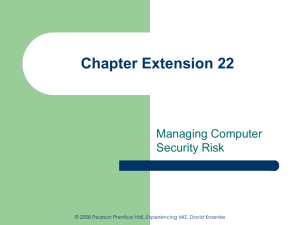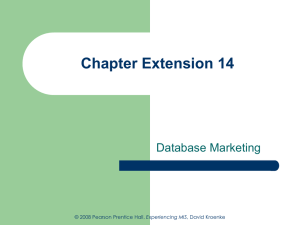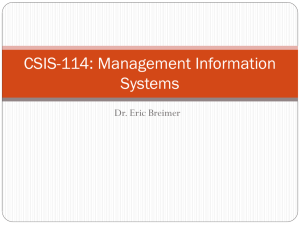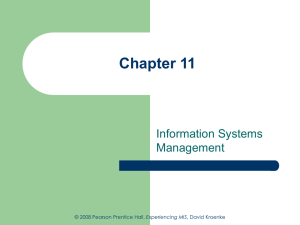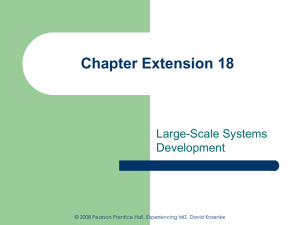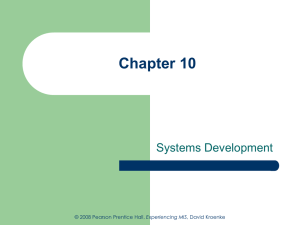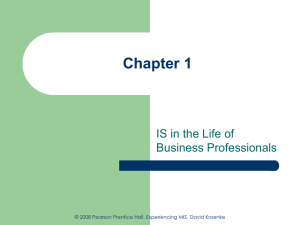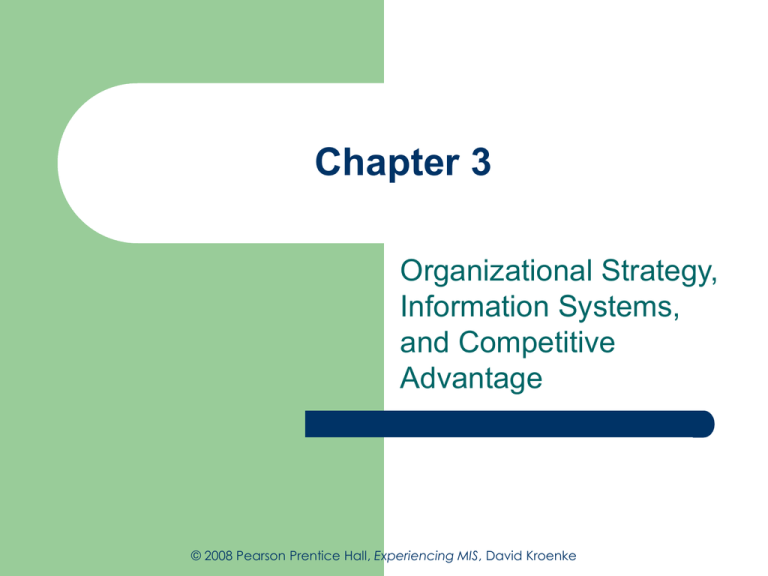
Chapter 3
Organizational Strategy,
Information Systems,
and Competitive
Advantage
© 2008 Pearson Prentice Hall, Experiencing MIS, David Kroenke
Study Questions
3-2
How does organizational strategy determine
information systems structure?
What five forces determine industry structure?
What is competitive strategy?
What is a value chain?
How do value chains determine business
processes?
How do information systems provide competitive
advantages?
How does the knowledge in this chapter help Dee?
© 2008 Pearson Prentice Hall, Experiencing MIS, David Kroenke
This Could Happen to You
Marketing Director needs to write memo to
her boss
–
–
3-3
Explain how blog would provide a competitive
advantage
Will be used to justify expense to his manager
© 2008 Pearson Prentice Hall, Experiencing MIS, David Kroenke
Study Questions
3-4
How does organizational strategy determine
information systems structure?
What five forces determine industry structure?
What is competitive strategy?
What is a value chain?
How do value chains determine business
processes?
How do information systems provide competitive
advantages?
How does the knowledge in this chapter help Dee?
© 2008 Pearson Prentice Hall, Experiencing MIS, David Kroenke
Organizational Strategy
3-5
Determines organization’s goal and
objectives
Developed from organizational structure
Creates the value chain for organization
Establishes the structure, features, and
functions of information systems
© 2008 Pearson Prentice Hall, Experiencing MIS, David Kroenke
Porter’s Five Forces
Figure 3-2
3-6
© 2008 Pearson Prentice Hall, Experiencing MIS, David Kroenke
What Five Forces Determine
Industry Structure?
Porter’s five competitive forces:
–
–
–
–
–
3-7
Bargaining power of customers
Threat of substitution
Bargaining power of suppliers
Threat of new entrants
Rivalry among existing firms
© 2008 Pearson Prentice Hall, Experiencing MIS, David Kroenke
Example of Five Forces
Figure 3-3
3-8
© 2008 Pearson Prentice Hall, Experiencing MIS, David Kroenke
What Is Competitive Strategy?
Organization’s response to structure of its industry
Porter identified four competitive strategies:
–
–
–
–
3-9
Cost leadership across industry
Cost leadership focused on particular industry segment
Differentiation across industry
Differentiation focused on particular industry segment
Porter says goals, objectives, culture, and activities
must be consistent with strategy
© 2008 Pearson Prentice Hall, Experiencing MIS, David Kroenke
Value Chain
Figure 3-5
3-10
© 2008 Pearson Prentice Hall, Experiencing MIS, David Kroenke
What Is a Value Chain?
3-11
Network of value-creating activities
Primary activities
Support activities
Linkages
© 2008 Pearson Prentice Hall, Experiencing MIS, David Kroenke
Primary Activities
Five activities
–
–
–
–
–
Stages accumulate costs and add value to product
–
3-12
Inbound logistics
Operations
Outbound logistics
Marketing and sales
Service
Net result is total margin of chain
© 2008 Pearson Prentice Hall, Experiencing MIS, David Kroenke
Support Activities
Four activities
–
–
–
–
Contribute indirectly to production, sale, and service
Add value and costs
–
3-13
Firm infrastructure
Human resources
Technological development
Procurement
Produce margin that is difficult to calculate
© 2008 Pearson Prentice Hall, Experiencing MIS, David Kroenke
Linkages
3-14
Interactions across value activities
Sources of efficiencies
Readily supported by information systems
Reduce inventory costs
© 2008 Pearson Prentice Hall, Experiencing MIS, David Kroenke
Business Process Design
Porter’s idea
–
–
–
Create integrated, cross-departmental business
systems
Do not automate or improve existing systems
Instead, create new processes
3-15
Integrate activities of all departments
Across entire value chain
© 2008 Pearson Prentice Hall, Experiencing MIS, David Kroenke
Business Processes
3-16
Network of activities, resources, facilities,
and information
Accomplish a business function
Implement value chains or portions of value
chains
© 2008 Pearson Prentice Hall, Experiencing MIS, David Kroenke
Organizational Strategy
Determines Information Systems
Figure 3-1
3-17
© 2008 Pearson Prentice Hall, Experiencing MIS, David Kroenke
Competitive Advantage via
Products
Organizations gain a competitive advantage
by:
–
–
–
3-18
Creating new products or services
Enhancing existing products or services
Differentiating their products or services
© 2008 Pearson Prentice Hall, Experiencing MIS, David Kroenke
Competitive Advantage via
Business Processes
Organizations can gain a competitive
advantage by implementing business
systems
–
Locking in customers
–
Locking in suppliers
3-19
High switching costs
Making it easy to connect to and work with organization
© 2008 Pearson Prentice Hall, Experiencing MIS, David Kroenke
Competitive Advantage via
Business Processes, continued
–
Create entry barriers
–
Establish alliances
–
Establish standards
Promote product awareness
Reducing costs
3-20
Making it expensive for new competition to enter market
Increased profitability
© 2008 Pearson Prentice Hall, Experiencing MIS, David Kroenke
ABC’s Information System
Uses information systems to maintain
customer account data
–
–
Package and information delivery system
–
3-21
Collects information for ABC
Saves customers time by automatically filling in
part of form
Customer can select delivery address and
generate shipping labels
© 2008 Pearson Prentice Hall, Experiencing MIS, David Kroenke
Applying Knowledge of Industry
Structure
Knowledge of industry structure gives
background and perspective
Makes it easier to talk with management
Enables Dee to:
–
–
–
3-22
Understand the organization’s competitive
advantage
Translate strategy into her project
Build a better blog
© 2008 Pearson Prentice Hall, Experiencing MIS, David Kroenke
Applying Knowledge of Industry
Structure, continued
Dee’s memo should incorporate:
–
List of competitive advantage factors
3-23
Help sales team differentiate themselves
Lock in customers
Raise barriers to market entry
© 2008 Pearson Prentice Hall, Experiencing MIS, David Kroenke
ABC’s Information System Created
a Competitive Advantage
Information systems create advantage by:
–
–
–
–
–
3-24
Enhancing existing products
Differentiating products
Locking in customers
Raising barriers to entry
Delivering net savings
© 2008 Pearson Prentice Hall, Experiencing MIS, David Kroenke
Ethics Guide
Searching the Internet is a matter of
knowledge and access
Digital divide between those who have
access and those who don’t
–
–
Divide continues to deepen
Internet access available at public places
–
3-25
Not everyone served
Not as convenient
Advantages accrue to those with access
© 2008 Pearson Prentice Hall, Experiencing MIS, David Kroenke
Ethics Guide, continued
–
–
Intellectual capital resides on Internet
Savings for businesses
3-26
Product support
Warehousing
Mailings
Digital divide segregates haves and havenots
© 2008 Pearson Prentice Hall, Experiencing MIS, David Kroenke
Ethics Guide, continued
3-27
Do organizations have a responsibility to
address this matter?
If most have access, do we have to supply
the few without printed materials?
Is it the government’s responsibility to supply
Internet service?
How can any economy compete with an
Internet-based economy in the global arena?
© 2008 Pearson Prentice Hall, Experiencing MIS, David Kroenke
Active Review
3-28
How does organizational strategy determine
information systems structure?
What five forces determine industry structure?
What is competitive strategy?
What is a value chain?
How do value chains determine business
processes?
How do information systems provide competitive
advantages?
How does the knowledge in this chapter help Dee?
© 2008 Pearson Prentice Hall, Experiencing MIS, David Kroenke

